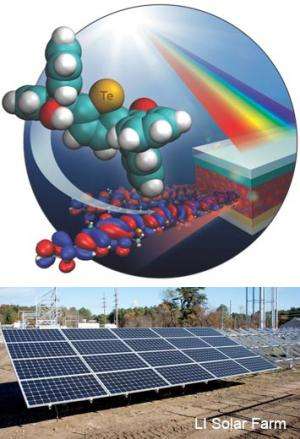Swapping tellurium for sulfur improves light absorption in organic solar cells

The investigation of light absorbing organic semiconductors is important for the development of lightweight flexible solar cells. Replacing sulfur atoms in commonly used, polymer-based solar cells with tellurium atoms results in materials that absorb a wider range of wavelengths of sunlight. A tellurophene-containing low-bandgap polymer (PDPPTe2T) was synthesized by microwave-assisted palladium-catalyzed ipso-arylative polymerization of 2,5-bis[(α-hydroxy-α,α-diphenyl)methyl]tellurophene with a diketopyrrolopyrrole (DPP) monomer.
This work has demonstrated that solar cells constructed from such polymers can convert sunlight into electrical current with an efficiency of 4.4% at wavelengths up to 1.0 microns. This result is a benchmark for tellurium-based polymer solar cells. Density functional theory calculations (DFT) suggest that the switch from sulfur to tellurium shifts the absorption spectrum toward longer wavelengths in the solar spectrum.
These are the first reported solar cells composed of such tellurium-based polymers. As well, these polymers absorb light across a broad range of wavelengths from ultraviolet to infrared, generating electricity at > 4% efficiency.
More information: "Polymerization of Tellurophene Derivatives by Microwave-Assisted Palladium-Catalyzed ipso-Arylative Polymerization." Angewandte Chemie International Edition 53 10691-10695 (2014). DOI: 10.1002/anie.201406068
Journal information: Angewandte Chemie International Edition
Provided by Brookhaven National Laboratory



















